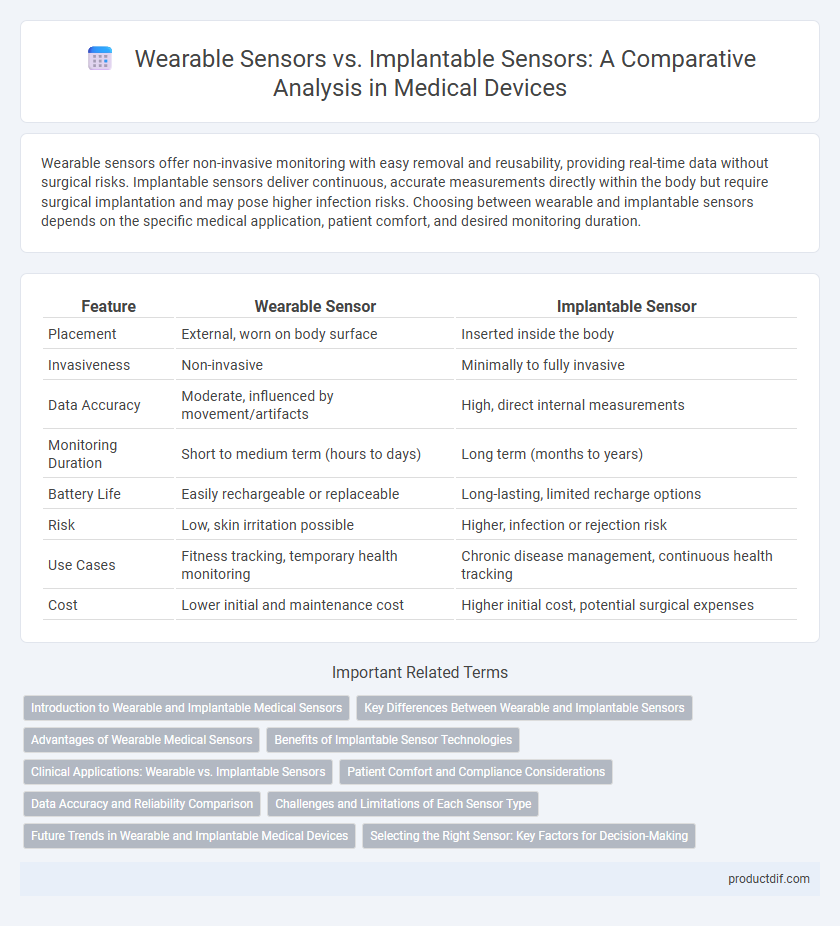Wearable sensors offer non-invasive monitoring with easy removal and reusability, providing real-time data without surgical risks. Implantable sensors deliver continuous, accurate measurements directly within the body but require surgical implantation and may pose higher infection risks. Choosing between wearable and implantable sensors depends on the specific medical application, patient comfort, and desired monitoring duration.
Table of Comparison
| Feature | Wearable Sensor | Implantable Sensor |
|---|---|---|
| Placement | External, worn on body surface | Inserted inside the body |
| Invasiveness | Non-invasive | Minimally to fully invasive |
| Data Accuracy | Moderate, influenced by movement/artifacts | High, direct internal measurements |
| Monitoring Duration | Short to medium term (hours to days) | Long term (months to years) |
| Battery Life | Easily rechargeable or replaceable | Long-lasting, limited recharge options |
| Risk | Low, skin irritation possible | Higher, infection or rejection risk |
| Use Cases | Fitness tracking, temporary health monitoring | Chronic disease management, continuous health tracking |
| Cost | Lower initial and maintenance cost | Higher initial cost, potential surgical expenses |
Introduction to Wearable and Implantable Medical Sensors
Wearable medical sensors are non-invasive devices designed to monitor physiological parameters such as heart rate, blood pressure, and glucose levels continuously, enabling real-time health data collection without disrupting daily activities. Implantable sensors, inserted surgically, provide direct internal monitoring for precise measurements of biochemical and electrical signals within the body, facilitating chronic disease management and advanced diagnostics. Both sensor types leverage biosensing technologies but differ in application scope, invasiveness, and data accuracy, playing complementary roles in personalized healthcare and remote patient monitoring.
Key Differences Between Wearable and Implantable Sensors
Wearable sensors are non-invasive devices worn externally to monitor physiological parameters such as heart rate, activity levels, and temperature, offering convenience and easy removal. Implantable sensors are surgically embedded within the body, providing continuous, real-time monitoring of biomarkers like glucose levels or cardiac rhythms with higher accuracy and sensitivity. Key differences include the level of invasiveness, data precision, longevity, and risk of infection or device rejection.
Advantages of Wearable Medical Sensors
Wearable medical sensors offer non-invasive continuous monitoring, enabling real-time data collection without the risks associated with surgical implantation. Their ease of use and portability enhance patient compliance and allow seamless integration with smartphones and health apps for remote health management. Furthermore, wearable sensors reduce infection risk and lower overall healthcare costs by avoiding surgical procedures and minimizing hospital visits.
Benefits of Implantable Sensor Technologies
Implantable sensor technologies provide continuous, real-time monitoring of physiological parameters with higher accuracy and reliability compared to wearable sensors, due to their direct interface with internal tissues. They enable early detection of critical health conditions such as cardiac arrhythmias and glucose fluctuations, improving patient outcomes through timely intervention. Enhanced biocompatibility and miniaturization of implantable sensors reduce infection risk and improve patient comfort during long-term use.
Clinical Applications: Wearable vs. Implantable Sensors
Wearable sensors offer non-invasive continuous monitoring of vital signs such as heart rate, oxygen saturation, and physical activity, making them ideal for outpatient and remote patient management. Implantable sensors provide more precise and long-term data collection directly within body tissues or organs, critical for chronic disease management and postoperative monitoring. Clinical applications of implantable sensors include glucose monitoring in diabetes and intracranial pressure measurement in neurology, while wearable sensors dominate in fitness tracking and early detection of cardiac arrhythmias.
Patient Comfort and Compliance Considerations
Wearable sensors offer enhanced patient comfort with non-invasive designs that minimize skin irritation and allow easy removal, promoting higher compliance during prolonged monitoring. Implantable sensors, while providing continuous and accurate data, may cause discomfort due to surgical insertion and potential tissue reactions, impacting patient willingness for long-term use. Careful assessment of patient lifestyle and medical needs is essential to balance comfort with data reliability in sensor selection.
Data Accuracy and Reliability Comparison
Wearable sensors offer non-invasive monitoring with moderate data accuracy influenced by external factors such as movement and environmental conditions, while implantable sensors provide higher precision due to direct physiological contact and reduced signal interference. Implantable sensors generally ensure greater data reliability over extended periods, benefiting from stable positioning and consistent signal acquisition, unlike wearable devices prone to displacement and signal disruption. The choice between wearable and implantable sensors depends on the clinical requirement for data fidelity, patient compliance, and monitoring duration.
Challenges and Limitations of Each Sensor Type
Wearable sensors often face challenges related to motion artifacts, skin irritation, and limited continuous monitoring capabilities due to battery life constraints. Implantable sensors, while offering more accurate and continuous data collection, encounter limitations such as invasive implantation procedures, risk of infection, biocompatibility issues, and potential sensor degradation over time. Both sensor types require advancements in durability, signal accuracy, and patient comfort to optimize their medical applications.
Future Trends in Wearable and Implantable Medical Devices
Future trends in wearable and implantable medical devices highlight advancements in non-invasive monitoring accuracy and biocompatible materials for prolonged sensor lifespan. Integration of AI algorithms enables real-time data analysis, enhancing personalized healthcare and early disease detection. Emerging technologies emphasize seamless connectivity between wearable and implantable sensors to create comprehensive health monitoring ecosystems.
Selecting the Right Sensor: Key Factors for Decision-Making
Choosing between wearable and implantable sensors depends on factors such as the accuracy required, patient comfort, and duration of monitoring. Implantable sensors typically provide more precise and continuous data but involve surgical risks and higher costs, while wearable sensors offer non-invasive, cost-effective monitoring with easier maintenance. Considerations include the specific medical condition, the need for long-term data, and patient lifestyle to optimize sensor selection for effective health management.
Wearable sensor vs Implantable sensor Infographic

 productdif.com
productdif.com